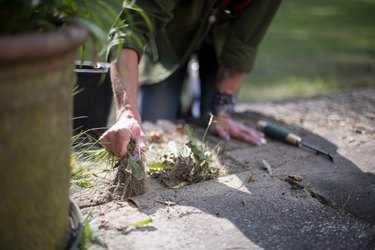
Weeds in the garden and along the hardscape are lush, green, and unwanted. While you may prefer natural methods of killing weeds, using an Epsom salt mixture to kill weeds isn't a permanent solution to the problem. It does provide nearly instant satisfaction as the weeds' leaves shrivel and die, but don't get the spray on desirable plants as it doesn't discriminate between the "good" and "bad" plants in your landscape.
Tip
The weed killing recipe combines Epsom salts, vinegar, and dishwashing liquid to make a solution to spray on weeds.
Video of the Day
Epsom Salt Weed Killer Recipe
The homemade weed killing recipe touted on blogs and in videos incorporates three simple ingredients, which you may already have in your kitchen cabinet. Put on your safety goggles and gloves; then mix 2 cups Epsom salts, 1 gallon of 5 percent white vinegar, and 1/4 cup dishwashing liquid in a large bowl or bucket. Using a funnel, pour the solution into a spray bottle and liberally apply to the weeds' leaves. Repeat the next day and then as needed throughout the growing season.
Video of the Day
Components of the Weed Killing Solution
While the ingredients seem simple, each has its benefits and risks. The magnesium sulfate in Epsom salts can benefit plants grown in sandy soils, where nutrients leach away quickly. Magnesium deficiency affects the chlorophyll in the plant leaves and growth, resulting in yellowing leaves and stunted growth. On the other hand, while Epsom salts contain magnesium instead of sodium, too much magnesium can affect the plant's ability to take up phosphorus and calcium, which are also essential nutrients for plant growth.
Vinegar, whether a household or horticultural concentration, is an acid. Even a 5 percent solution can burn your eyes and skin, and the 20 percent horticultural solution should be treated with care. Vinegar damages the weed's leaves as well as any surrounding vegetation.
Dishwashing detergent is used in the recipe as a surfactant. It helps the solution "stick" to the leaves so the vinegar and Epsom salts can severely damage and kill the leaves. It's not a "natural" ingredient and contains chemicals that in large amounts can affect groundwater and aquatic life.
Effectiveness of Epsom Salt to Kill Weeds
The Epsom salt solution is effective in killing the leaves of weeds and surrounding vegetation. With repeated use, shallow-rooted weeds can be knocked back and may not regrow. However, deep-rooted perennial weeds like dandelions (Taraxacum spp.), which thrive in U.S. Department of Agriculture plant hardiness zones 3 through 10, will grow back from the unaffected tap roots. In addition, because of the magnesium sulfate in Epsom salts, your attempt to kill the weeds does result in temporary foliage loss but then provides much-needed nutrients to the weeds' roots to encourage rapid regrowth.
Another Natural Weed Killing Method
One of the most effective natural weed killing methods is hand-pulling. Wet the soil thoroughly with a hose to soften it; then put on your gloves, grab a weed-pulling tool or trowel, and yank the weeds out by the roots. Use a stand-up tool to loosen the soil and get as much of the root system as possible. Alternatively, sit on a stool or kneel on a cushioned kneeling pad to protect your back and knees.
After removing as many weeds as possible, cover the soil with landscape fabric, several layers of newspapers or cardboard, then a 3- to 4-inch layer of mulch to discourage weed seed germination. Pull weed seedlings as soon as they appear.
- Avian Web: Safe Alternatives for Weed Control, Pesticides / Insecticides
- University of Florida IFAS: Home Garden Remedies, Helpful or Harmful?
- University of Minnesota Extension: Magnesium for Crop Production
- University of Connecticut College of Agriculture, Health and Natural Resources: Extension News: Epsom Salts
- Oregon State University: OSU Extension Service: How Can I Naturally Kill Dandelions?
- University of California Agriculture and Natural Resources: Hand Weeding